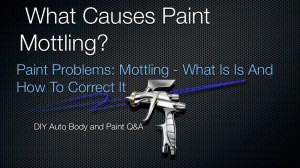 Paint mottling is something that many painters have had happen to them. If you’ve done any auto painting, chances are that you have had paint mottling.
Paint mottling is something that many painters have had happen to them. If you’ve done any auto painting, chances are that you have had paint mottling.
Mottling is where for the metallic gathers together in areas or bunches together and gives it uneven or blotchy look. This is usually caused by spraying the base coat too wet resulting in the metallic flakes moving around bunching together. Mottling can also happen spraying pearls.
[youtube]http://www.youtube.com/watch?v=VJ2BgJC1BdE[/youtube]
This can also be caused by using the wrong reducer, however spraying the base coat to wet is the most common cause that I have seen. To eliminate this problem, spray your base coat with medium wet coats. If you are spraying your base coat and you are achieving a glossy or extremely wet coat when spraying, you are probably spraying too wet. Ways to spray a medium wet coat if you spraying too wet could include: decreasing fluid, moving faster, or holding the gun further from the surface being painted.
Watch the video for a few steps that would help you eliminate having this problem.
For more auto body and paint tutorials, subscribe to our newsletter to stay updated.
Be sure to like this post and share with your friends.